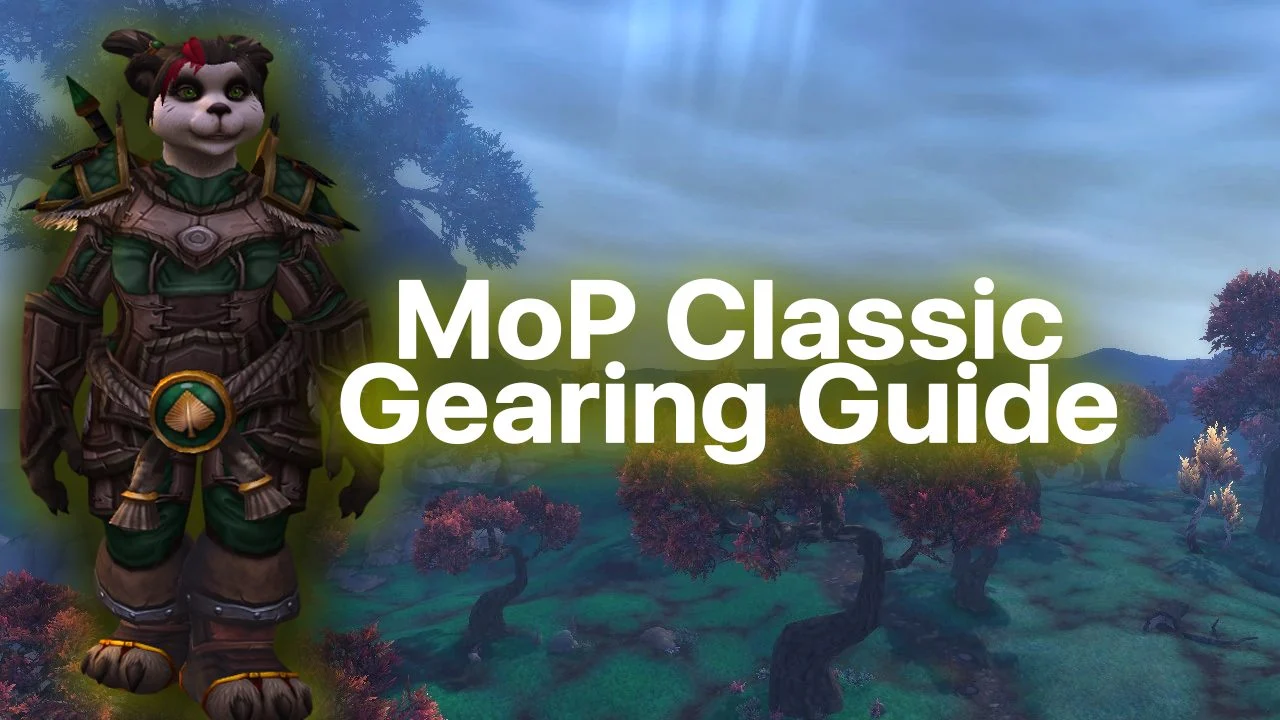- > MoP Classic Darkmoon Faire Guide: Tips, Rewards & Buffs
- > MoP Classic Blood Spirit Guide: Farming, Usage, and Selling Tips
- > Blizzard Surveys Users About Potential Merge of Classic and Retail WoW
- > The Complete MoP Classic Reputation Guide and What To Prioritize
- > MoP Classic Sha of Anger Respawn Time & Locations Guide
- > WoW MoP Classic Engineering Guide - Leveling 1-600 Fast & Easy
How to Upgrade Gear in MoP Classic - Complete Guide
Getting Your Gear Right in MoP Classic
Let’s face it—gearing up in Mists of Pandaria Classic isn’t always as straightforward as we’d like. There's no Valor upgrade track like in modern WoW, and that means if you're not lucky with drops, you'll need to get creative with how you improve your gear. Luckily, MoP Classic offers a couple of systems that let you squeeze out more performance without having to rely entirely on RNG.
If you’re feeling stuck because you’re low on gold, check out PVPBank. It’s one of the more dependable ways to buy MoP Classic gold fast and safely, so you can actually afford all those reforges and enchants without grinding yourself into the ground.
Let’s walk through how to upgrade gear in MoP Classic, how reforging works, what stats you should care about, and how to approach this whole process like a seasoned player.
Where Do You Upgrade Gear?
If your gear is item level 458 or higher, congrats—you’re eligible to upgrade it.
To do so, you’ll need to find the Voidbinders:
-
Alliance players should head to Voidbinder Lunshur in the Shrine of Seven Stars.
-
Horde players can visit Voidbinder Shadzor in the Shrine of Two Moons.
Once you’re there, here’s how upgrades break down:
-
Rare (blue) PvE items – can be upgraded once for +8 item levels using 50 Lesser Charms of Good Fortune.
-
Epic (purple) PvE items – can be upgraded twice (4 item levels per upgrade) for a total of +8, again costing 50 charms each time.
-
Siege of Orgrimmar gear (when SoO is released) – will eventually allow a total of +16 item levels after four upgrades.
It’s simple in practice, but you’ll need to keep farming those charms.
What’s Reforging, and Why Should You Care?
Reforging is basically Blizzard’s way of letting us tweak our gear stats without having to hunt down the perfect item. It allows you to shift 40% of one secondary stat into another. For example, if your gear has too much Crit but you really need more Hit, you can reforge some of that Crit into Hit.
This was huge in MoP, especially when you're trying to hit important stat caps like Hit Rating or Expertise. It's also a big deal for healers and tanks trying to fine-tune regen or survivability.
Just keep in mind:
-
You can only reforge one stat per item.
-
Only secondary stats are eligible.
-
You can’t convert a stat into itself or one that’s already present.
Which Stats Can Be Reforged?
You can reforge:
-
Hit Rating
-
Expertise
-
Haste
-
Critical Strike
-
Mastery
-
Spirit
-
Dodge and Parry
You can’t reforge:
-
Strength, Agility, Intellect, Stamina
-
Resilience, PvP Power
-
Armor
-
Socket bonuses or set effects
This means reforging won’t completely change your gear, but it gives you just enough flexibility to make it feel tailor-made.
Where to Reforge Your Gear
You’ll find Reforging NPCs in the usual spots—main cities like Orgrimmar, Stormwind, and in Pandaria’s hubs. Look for Ethereals labeled as “Arcane Reforger” or “Warpweaver.” They’re hard to miss.
The cost to reforge depends on your item’s vendor value. Higher-level gear costs more gold to tweak.
Best Practices for Reforging
If you're new to this or haven't reforged in a while, here are a few tips:
1. Finish Enchanting and Gemming First
It’s best to do all your other enhancements before reforging. That way, you know exactly what stat gaps remain.
2. Use Your Character Sheet
After each reforge, check your stats. Overcapping Hit or Expertise is a waste.
3. Don’t Stress About Mistakes
You can revert any reforge with the Restore option. There’s no long-term penalty for experimenting.
4. Don’t Bother with Low-End Gear
Save your gold for reforging epics and BiS pieces. Don’t waste gold on green quest gear or early dungeon blues.
Key Stat Caps to Know in MoP Classic
If you're serious about performance, you’ll want to hit specific stat thresholds. Here’s what to aim for:
| Stat | Goal |
|---|---|
| Hit Cap (Raid Bosses) | 7.5% = 2550 Hit Rating |
| Caster Hit Cap | 15% = 5100 Hit Rating (often helped by Spirit) |
| Expertise Cap | 7.5% = 2550 Expertise |
| PvP Hit Cap | 3% = 1020 Hit Rating |
| Spirit | Typically between 4000–6000, depending on your role |
| Haste | Breakpoints vary by class/spec, mostly used for GCD or DoT optimization |
Reforging by Role: Quick Examples
Melee DPS:
-
Hit and Expertise first.
-
Then focus on Crit or Mastery depending on spec.
Casters:
-
Reach Hit cap (using Spirit for hybrids).
-
Then Haste or Crit, based on DoT breakpoints.
Healers:
-
Spirit is your main concern.
-
Then look at Haste breakpoints or Mastery for throughput.
Tanks:
-
Prioritize Dodge, Parry, or Hit for threat.
-
Mastery is strong for shield-based tanks.
When Should You Upgrade or Reforge?
You don’t need to reforge every piece the second you get it. Think about longevity. If it’s a throwaway item, skip it. But if it’s BiS or something you’ll hold onto for a while, go for it.
A good rule:
-
Upgrade gear once it hits 458+ iLvl.
-
Reforge after enchanting and gemming.
-
Revisit after major gear changes or respecs.
Running Low on Gold?
Reforging, enchanting, gemming—it all adds up. If farming gold is starting to wear on you, sites like PVPBank can help you buy MoP Classic gold safely, so you can keep your focus on what matters: playing the game.
Upgrading gear in MoP Classic isn’t just about grabbing better drops. It’s about being smart—knowing how to use reforging, Lesser Charms, and your stat priorities to build a better character.
Whether you’re raiding, PvPing, or tanking dungeons, small upgrades can make a big difference. And now that you know where to upgrade, what to reforge, and how to do it efficiently—you’re way ahead of most players already.

